When selecting chip capacitors, engineers often find themselves confused by terms like C0G, X5R, Y5V, and Z5U. While they all fall under the category of ceramic capacitors, these designations—defined by the EIA (Electronic Industries Alliance)—represent critical differences in temperature stability and performance. At their core, these variations stem from the unique dielectric materials used in their construction, which directly impact how capacitance changes with temperature, voltage, and frequency. Let’s break down their characteristics, applications, and key distinctions.

Core Differences: Temperature Stability and Dielectric Properties
All these capacitors have their capacitance and tolerance defined at 25°C (room temperature). However, when operating outside this range—whether exposed to extreme heat or cold—their capacitance shifts significantly. This temperature coefficient, along with dielectric constant and loss characteristics, is what sets them apart.
1. C0G (EIA Code) / NP0 (Industry Terminology)
- Dielectric Traits: C0G (also called NP0, short for "Negative-Positive Zero") uses a dielectric material with minimal temperature sensitivity. Its temperature coefficient is extremely low: 0 ± 30 ppm/°C. This means capacitance changes by less than ±0.05% even with fluctuations in temperature, voltage, or frequency.
- Performance Highlights: Low dielectric loss (tanδ) makes it ideal for high-frequency applications, up to Gbps-level circuits. However, its dielectric constant is relatively low, limiting maximum capacitance to typically <10 nF.
- Typical Applications: Critical for circuits requiring precision, such as filters, clock oscillators, crystal matching circuits, and RF modules. It’s also used in 5G base stations, radar systems, and medical devices where stability is non-negotiable.
- Related Materials: Similar low-temperature-coefficient dielectrics include P350 and N1000/M3K, used in specialized industrial settings.
2. X7R
- Dielectric Traits: X7R is a temperature-stable dielectric with a moderate dielectric constant. It maintains stable electrical performance across a wide temperature range (-55°C to +125°C), with capacitance shifting by only ±15% within this interval. Its aging rate is low: 1% per 10 years.
- Performance Highlights: Balances stability and capacitance range, typically available from 100 pF to 2.2 µF. It handles voltage variations better than lower-stability types, making it a workhorse in industrial settings.
- Typical Applications: Used in DC blocking, signal coupling, bypass circuits, and frequency discrimination circuits where moderate stability is sufficient. Common in industrial controllers (PLCs), automotive electronics, and power management modules.
3. Y5V
- Dielectric Traits: Y5V uses a high-dielectric-constant material, enabling large capacitance in small packages. However, its stability is poor: capacitance shifts drastically within its operating temperature range (-30°C to +85°C), with a tolerance of +22% to -82%. Its aging rate is higher at 5% per 10 years.
- Performance Highlights: Offers the largest capacitance range among these types (1000 pF to 10 µF) but is highly sensitive to temperature, voltage, and frequency. Dielectric loss is also higher compared to X7R or C0G.
- Typical Applications: Suitable for non-critical, cost-sensitive applications where size and capacitance matter more than precision. Examples include bypass circuits in consumer electronics (smartphones, TVs), low-power sensors, and basic audio equipment.
4. Z5U
- Dielectric Traits: Z5U features a high dielectric constant, allowing large capacitance in compact sizes. It has low equivalent series inductance (ESL) and equivalent series resistance (ESR), delivering good frequency response. However, its temperature range is narrow (+10°C to +85°C), with capacitance shifting by +22% to -56%.
- Performance Highlights: Classified as a Class II ceramic (ferroelectric dielectric), it offers high capacitance density but with non-linear temperature characteristics and higher loss.
- Typical Applications: Primarily used in decoupling circuits for digital ICs, where rapid energy storage and release are needed. Also suitable for bypass and coupling in devices operating near room temperature, such as laptops, routers, and LED drivers with low DC bias.
5. X5R
- Dielectric Traits: X5R is a stable Class II ceramic dielectric with a high dielectric constant. It operates reliably from -55°C to +85°C, with capacitance shifting by ±15%—similar to X7R but with a narrower upper temperature limit.
- Performance Highlights: Available in larger capacitances (typically 100 pF to 10 µF) and balances size and stability, making it a popular choice for compact designs.
- Typical Applications: Used in oscillators, filter circuits, and power supply bypassing in consumer electronics (wearables, IoT devices) and automotive infotainment systems, where operation is within moderate temperature ranges.
Capacitance, Voltage, and Size: How They Relate
The physical size of a chip capacitor directly impacts its maximum capacitance and voltage rating:

- Smaller packages (e.g., 0201: 0.6mm × 0.3mm) are limited to lower capacitances and voltages. For example, 0201 caps max out at 2.2 µF with a 6.3V rating and ±20% tolerance.
- Larger packages (e.g., 0805: 2.0mm × 1.25mm) can achieve higher capacitances but often at the cost of lower voltage handling. A 0805 cap, for instance, reaches up to 47 µF but with a maximum voltage of 10V.
- In general: Smaller size = lower capacitance/voltage; larger size = higher capacitance but lower voltage tolerance. This trade-off guides in space-constrained designs (e.g., smart watches) vs. power-focused applications (e.g., industrial power supplies).
ICgoodFind’s Take
Understanding the nuances of X5R, X7R, Y5V, Z5U, and C0G is critical for precise component selection. At ICgoodFind, we stock a full range of these ceramic capacitors, helping engineers match the right dielectric to their application—whether it’s high-precision RF circuits or cost-sensitive consumer devices. Our technical team can assist with 选型 guidance, ensuring optimal performance and reliability.










